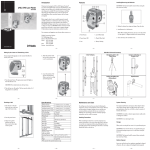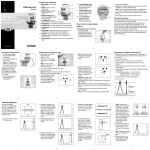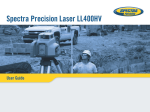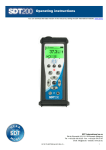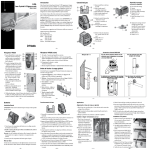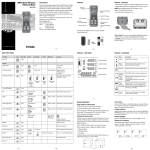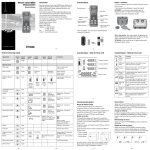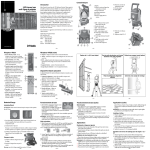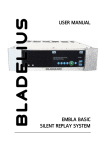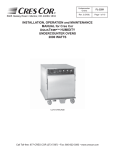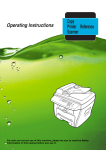Download Spectra LL100-2 User's Manual
Transcript
GB Thank you for choosing one of the Spectra Precision Lasers from the Trimble family of precision horizontal lasers. The LL100 is a simple-to-use laser that allows you to take accurate horizontal measurements, using a handheld or rod mounted receiver. TABLE OF CONTENTS FOR YOUR SAFETY COMPONENTS How to Use the Laser System Powering the Laser Laser Setup Turning On/Off the Laser Activating/Deactivating Standby Mode Using the Manual Mode Using the Y- Single Slope Mode APPLICATIONS General Construction Determining the Height of Instrument (HI) Using the Y-Axis Single Slope Mode CALIBRATION Checking Calibration of the Y- and X-Axes PROTECTING THE UNIT CLEANING AND MAINTENANCE PROTECTING THE ENVIRONMENT WARRANTY TECHNICAL DATA 5 6 6 6 6 6 6 7 7 7 7 7 7 8 8 8 8 8 9 9 FOR YOUR SAFETY For hazardless and safe operation, read all the user guide instructions. IEC/EN 60825-1: 2001, max. 3.0 mW, t < 0.25 sec, 630 –680 nm LASER LIGHT DO NOT STARE INTO BEAM CLASS 2 LASER PRODUCT CDRH 21 CFR 1040.10 AND 1040.11 • Use of this product by people other than those trained on this product may result in exposure to hazardous laser light. • Do not remove warning labels from the unit. • The LL100 is Class 2 (< 3mW, 600 ... 680 nm). • Never look into the laser beam or direct it to the eyes of other people. • Always operate the unit in a way that prevents the beam from getting into people‘s eyes. • If initial service is required, which results in the removal of the outer protective cover, removal must only be performed by factory-trained personnel. Caution: Use of other than the described user and calibration tools or other procedures may result in exposure to hazardous laser light. Caution: Using the unit different than described at the LL100 user guide, may result in unsafe operation. 5 .COMPONENTS 1 2 3 4 5 6 7 8 9 10 11 12 13 14 15 Power Button Battery LED Manual/Standby Button Leveling LED Manual/HI-Warning LED Up and Down Arrow Buttons Left and Right arrow Buttons (remote control) Infrared-receiver for remote control Removable Rotor Cage Sighting Guides Rotor/Beam Exit Handle Battery compartment/door 5/8x 11 Tripod Mounts Rubber feet How to Use the Laser System Powering the Laser Batteries Installing Batteries Open the battery door using your fingers, a coin or a screwdriver. Insert batteries into the housing so that the negative poles are toward the bigger battery spiral spring. Push down on the battery door until the latch “clicks” into position. Laser Setup Position the laser horizontally or vertically (tripod mount and rubber feet downward!) on a stable platform, wall mount or tripod at the desired elevation. The laser recognizes automatically whether it is used horizontally or vertically when switched on. Note: The laser always operates in MANUAL mode in the Vertical position. Turning On/Off the Laser Press the power button 1 to turn on the laser. Note: The laser always powers up in the automatic self-leveling mode. The LEDs (2, 4 and 5) are turned on for 2 seconds. The laser is level when the leveling indicator 4 is no longer flashing (once every second). For the first five minutes after the laser self levels, the LED 4 lights solid. After five minuts the LED 4 starts flashing every four seconds to let you know the laser is still level while conserving battery life. If the laser is positioned beyond it´s self-leveling range of ±8%, the laser beam, and manual and leveling indicators flash simultaneously. Turn the unit off, reposition the laser within the self-leveling range and turn it on again. Note: If the laser is out of its self-leveling range and remains out of it for more than 10 minutes, the unit shuts down completely. Note: After the laser has been level for more than 5 minutes in horizontal mode, the HI (height of instrument) alert activates. If the laser is disturbed (tripod bumped, etc.) so that when it re-levels the laser beam elevation changes by more than 3 mm (1/8 in.), the HI alert shuts down the laser and rotor, and the red LED flashes two times per second (twice the manual-mode rate). To restore level, turn the laser off and on. After the laser has re-leveled, check your initial reference elevation. In order to switch the laser off, press the power button again. Activating/Deactivating Standby Mode Standby mode is a power-saving feature that conserves laser battery life. Press and hold the laser’s or remote control’s manual button for 3 seconds to activate standby mode. Note: When standby mode is activated, the laser beam, rotor, self-leveling system, and LEDs shut down, but the HI alert remains activated. 6 To let you know that the laser is in standby mode, the battery LED flashes every 4 seconds. To deactivate standby mode and restore full operation of the laser, press and hold the laser’s or remote control’s manual button for 3 seconds. The laser and all other functions turn on again. Using the Manual Mode In horizontal mode pressing the manual button on the laser or the remote control changes the laser from automatic self-leveling mode to Manual mode. Manual mode is indicated by the flashing (once every second) red LED 5. In Manual mode (horizontal), the Y-axis can be sloped by pressing the Up- and Down-Arrow-buttons on the laser‘s keypad or the remote control. Additionally, the X-axis can be sloped by pressing the Left- and Right-Arrowbuttons on the remote control. To resume automatic self-leveling mode, press the manual button again. In vertical mode, the laser is always in MANUAL mode. Pressing the up and down arrow buttons align the laser beam to the right/left side, and the left and right arrow buttons at the remote control adjust the slope of the laser beam. To resume automatic self-leveling mode, press the manual button again. Using the Y- Single Slope Mode The Manual button on the remote control toggles the unit to Manual, the Y-axis Single Slope Mode, then Automatic Mode. To activate the Y-axis single slope mode, press the manual button at the remote control twice. This is indicated by the simultaneously flashing red 5 and green 4 LEDs (once every second). In Y-axis single slope mode, the Y-axis can be sloped by pressing the Up- and Down-Arrow-buttons on the laser or the remote control, while the X-axis remains in automatic self leveling mode (e.g. when setting up sloped ceilings or drive ways). To resume automatic self-leveling mode from Y-axis single slope mode, press the manual button again. APPLICATIONS General Construction Determining the Height of Instrument (HI) The height of instrument (HI) is the elevation of the laser’s beam. The HI is determined by adding the grade-rod reading to a benchmark or known elevation. 1. Set up the laser and place the grade rod on a job-site benchmark (BM) or known elevation. 2. Slide the receiver up/down the grade rod until it shows an on-grade reading. 3. Add the grade-rod reading to the benchmark to determine the height of instrument. Example: Benchmark = 30.55 m (100.23 ft) Rod reading = +1.32 m (+4.34 ft) Height of instrument = 31.87 m (104.57 ft) Use this HI as a reference for all other elevations. 1.32 m (4.34 ft) HI 30.55 m (100.23 ft) Using the Y-Axis Single Slope Mode 1. Set up the laser over the reference point (A). 2. Look over the rotor to align the laser to the desired direction hub in the axis that is supposed to be used in automatic self-leveling mode. Turn the laser on the tripod until it is properly aligned. 3. Attach a receiver to a grade rod. Set the grade rod on the self-leveling axis direction hub to check the laser’s elevation (B). B Note: Use this HI as a reference for checking the alignment of the laser after setting the slope for the other axis. 4. Activate the Y-axis single slope mode by pressing the manual button at the remote control twice. 5. Check the laser’s elevation on the slope axis directly in front of the laser. A C 7 6. Set the grade rod on the slope axis direction hub to adjust the laser’s elevation without changing the height of the receiver on the grade rod (C). 7. Press the up and down arrow buttons until you get an on-grade reading on the receiver. 8. Recheck the laser’s elevation in automatic self-leveling axis using the HI in step 3 (B). If the HI has been changed, rotate the laser on the tripod until you get an on-grade reading again. Make sure, you DON’T change the height of the receiver on the grade rod. CALIBRATION Checking Calibration of the Y- and X-Axes 1. Set up the laser 30 m (100 ft) from a wall and allow it to level. 2. Raise/lower the receiver until you get an on-grade reading for the +Y axis. Using the on-grade marking notch as a reference, make a mark on the wall. Y+ Y1 Note: For increased precision, use the fine-sensitivity setting (1.5 mm/1/16 in.) on the receiver. 30 m (100 ft) 3. Rotate the laser 180° (-Y axis toward the wall) and allow the laser to re-level. 4. Raise/lower the receiver until you get an on-grade reading for the –Y axis. Using the on-grade marking notch as a reference, make a mark on the wall. 5. Measure the difference between the two marks. If they differ more than 6 mm at 30 m (1/4 inch at 100 feet), the laser needs calibrating. -Y Y2 30 m (100 ft) 6. After checking the Y-axis, rotate the laser 90°. Repeat the above starting with the + X axis facing the wall. Note: If calibration is required, please, refer to the calibration instructions on our Trimble website www.trimble.com/support.shtml x+ 30 m (100 ft) PROTECTING THE UNIT Do not expose the unit to extreme temperatures or temperature changes (do not leave inside the car). The unit is very robust and can resist damage if dropped even from tripod height. Before continuing your work, always check the leveling accuracy. See Checking Calibration section. The laser is water protected and can be used indoors and outdoors. CLEANING AND MAINTENANCE Dirt and water on the Rotor/Beam Exit (Component 11) will influence beam quality and operating range considerably. Remove dirt on the housing with a lint-free, warm, wet and smooth cloth. Do not use harsh cleansers or solvents. Allow the unit to air dry after cleaning it. 8 PROTECTING THE ENVIRONMENT The unit, accessories and packaging ought to be recycled. This manual is made of non-chlorine recycling paper. All plastic parts are marked for recycling according to material type. Do not throw used batteries into the garbage, water or fire. Remove them in compliance with environmental requirements. Notice to Our European Union Customers For product recycling instructions and more information, please go to: www.trimble.com/environment/summary.html Recycling in Europe To recycle Trimble WEEE, call: +31 497 53 2430, and ask for the “WEEE associate,” or mail a request for recycling instructions to: Trimble Europe BV c/o Menlo Worldwide Logistics Meerheide 45 5521 DZ Eersel, NL 3 Year Limited Warranty Trimble warrants the LL100 to be free of defects in material and workmanship for a period of three years. For the first 12 months, Trimble or its authorized service center will repair or replace, at its option, any defective part, or the entire product, for which notice has been given during the warranty period. For months 13 through 36 an exchange fee may apply. If required, travel and per diem expenses to and from the place where repairs are made will be charged to the customer at the prevailing rates. Customers should send the product to Trimble Navigation Ltd. or the nearest authorized service center for warranty repairs or exchange, freight prepaid. Any evidence of negligent, abnormal use, accident, or any attempt to repair the product by other than factory-authorized personnel using Trimble certified or recommended parts, automatically voids the warranty. The foregoing states the entire liability of Trimble regarding the purchase and use of its equipment. Trimble will not be held responsible for any consequential loss or damage of any kind. This warranty is in lieu of all other warranties, except as set forth above, including any implied warranty merchantability of fitness for a particular purpose, are hereby disclaimed. This warranty is in lieu of all other warranties, expressed or implied. TECHNICAL DATA Leveling accuracy1,3: Rotation: Operational area1,2: Laser type: Laser class: Self-leveling range: Leveling time: Leveling indicators: Laser beam diameter1: Operating range using remote control: Power supply: Battery life1: Dust- and waterproof: Operating temp.: Storage temp.: Tripod attachments: Weight: Low voltage indication: Low voltage disconnection: ± 3 mm/30 m, 1/8“ @ 100 ft, 20 arc seconds appr. 600 rpm appr. 300 m (1000 feet) diameter with detector red diode laser 650 nm Class 2, <3mW appr. ± 5° appr. 30 sec LED flashes appr. 5 mm up to 30m (100 ft) 2 x 1.5V Mono cells type D (LR20) alkaline: 80 hours; NiMH: 35 hours IP54 23°F...113°F (-5°C ... 45°C) -4°F...158°F (-20°C ... 70°C) 5/8 x 11 horizontally and vertically 1.5 kg (3.3 lbs) flashing/shining of the battery indicator unit shuts off 1) at 21° Celsius 2) under optimal atmospheric circumstances 3) along the axis 9 DECLARATION OF CONFORMITY We Trimble Kaiserslautern GmbH declare under our sole responsibility that the product HV101 to which this declaration relates is in conformity with the following standards IEC 61010-1; IEC 60825-1; EN 61000-6-3:2007; EN 55022:2006; EN 61000-6-2:2005; EN 61000-4-2:1995 + A1:1998 + A2:2001; EN 61000-4-3:2002 + A1:2002 2004/108/EC following the provisions of directive Electromagnetic compatibility 89/336/EEC. The managing director Electro-Magnetic Compatibility Declaration of Conformity This digital apparatus does not exceed the Class B Limits for radio noise for digital apparatus set out in the Radio Interference Regulations of the Canadian Department of Communications. This device complies with part 15 off the FCC rules. Operation is subject to the condition that this device does not cause harmful interference. Note: The product been tested and found to comply with the limits for a Class B digital device, pursuant to part 15 of the FCC rules. These limits are designed to provide reasonable protection against harmful interference in a residential installation. The product generates, uses and can radiate radio frequency energy and, if not installed and used in accordance with the instructions, may cause harmful interference to radio or television reception, which can be determined by turning the product off and on. The user is encouraged to try to eliminate the interference by one or more of the following measures: • Reorient or relocate the receiving antenna. • Increase the separation between the product and the receiver. • For more information, consult your dealer or an experienced radio/television technician. Caution: Changes or modifications to the product that are not expressly approved by Trimble could void authority to use the equipment. 10 Service and Customer Advice North America Trimble Construction Division 5475 Kellenburger Road Dayton, Ohio 45424-1099 U.S.A. (800) 538-7800 (Toll Free) +1-937-245-5600 Phone +1-937-233-9004 Fax Europe Trimble GmbH Am Prime Parc 11 65479 Raunheim GERMANY +49-6142-2100-0 Phone +49-6142-2100-550 Fax Latin America Trimble Navigation Limited 6505 Blue Lagoon Drive Suite 120 Miami, FL 33126 U.S.A. +1-305-263-9033 Phone +1-305-263-8975 Fax Africa & Middle East Trimble Export Middle-East P.O. Box 17760 Jebel Ali Free Zone, Dubai UAE +971-4-881-3005 Phone +971-4-881-3007 Fax Asia-Pacific Trimble Navigation Australia PTY Limited Level 1/120 Wickham Street Fortitude Valley, QLD 4006 AUSTRALIA +61-7-3216-0044 Phone +61-7-3216-0088 Fax China Trimble Beijing Room 2805-07, Tengda Plaza, No. 168 Xiwai Street Haidian District Beijing, China 100044 +86 10 8857 7575 Phone +86 10 8857 7161 Fax www.trimble.com.cn 83












